Ruby Tuesday Bundle
What's the Story Behind Ruby Tuesday?
Journey back to 1972, when Ruby Tuesday, a titan of casual dining, first opened its doors in Knoxville, Tennessee. Founded by Samuel E. (Sandy) Beall III, the restaurant aimed to redefine dining with a relaxed yet quality-focused approach. This marked the beginning of a culinary adventure.
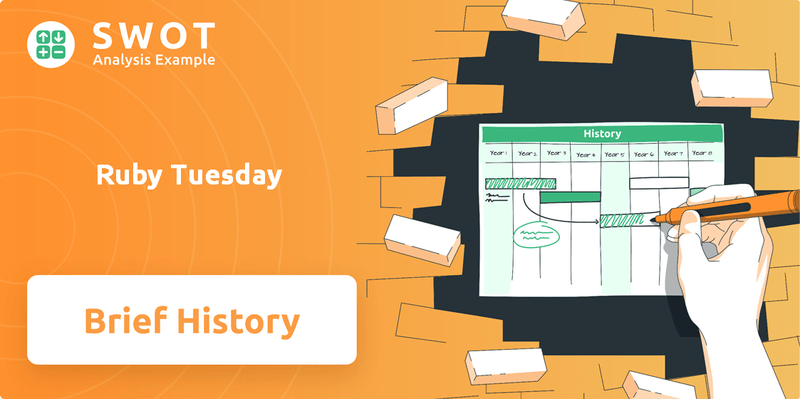
From its inception, Ruby Tuesday's Ruby Tuesday SWOT Analysis reveals a fascinating Ruby Tuesday history, shaped by strategic decisions and market dynamics. Explore the Ruby Tuesday restaurant's evolution, from its initial menu to its expansion across multiple Ruby Tuesday locations, and understand the challenges and triumphs that have defined its legacy. Discover the Ruby Tuesday timeline, including its founder, key milestones, and its enduring impact on the casual dining landscape.
What is the Ruby Tuesday Founding Story?
The Growth Strategy of Ruby Tuesday started with a simple idea: create a casual dining experience for a younger crowd. This vision materialized on February 19, 1972, marking the beginning of what would become a well-known restaurant chain. The story of the company is a testament to entrepreneurial spirit and adapting to the changing tastes of diners.
The initial concept was the brainchild of Samuel E. (Sandy) Beall III, a 21-year-old student at the University of Tennessee. He saw an opportunity to offer a relaxed dining environment, similar to the emerging 'fern bar' concepts. With an initial investment, the first restaurant was opened near the university's campus in Knoxville.
The original restaurant, housed in a converted Victorian house, quickly gained popularity. It focused on handmade burgers and a salad bar, which was a novel concept at the time. The restaurant also offered beer and wine, adding to its casual atmosphere. This early success laid the foundation for the company's future expansion.
The company was founded on February 19, 1972, by Samuel E. (Sandy) Beall III. The first restaurant was located in Knoxville, near the University of Tennessee campus.
- Beall secured an initial $10,000 investment from a Pizza Hut operator and pooled an additional $10,000 with fraternity brothers.
- The original Ruby Tuesday restaurant was in a converted Victorian house.
- The menu featured handmade burgers with unique toppings and a salad bar.
- The restaurant offered beer and wine.
Ruby Tuesday SWOT Analysis
- Complete SWOT Breakdown
- Fully Customizable
- Editable in Excel & Word
- Professional Formatting
- Investor-Ready Format
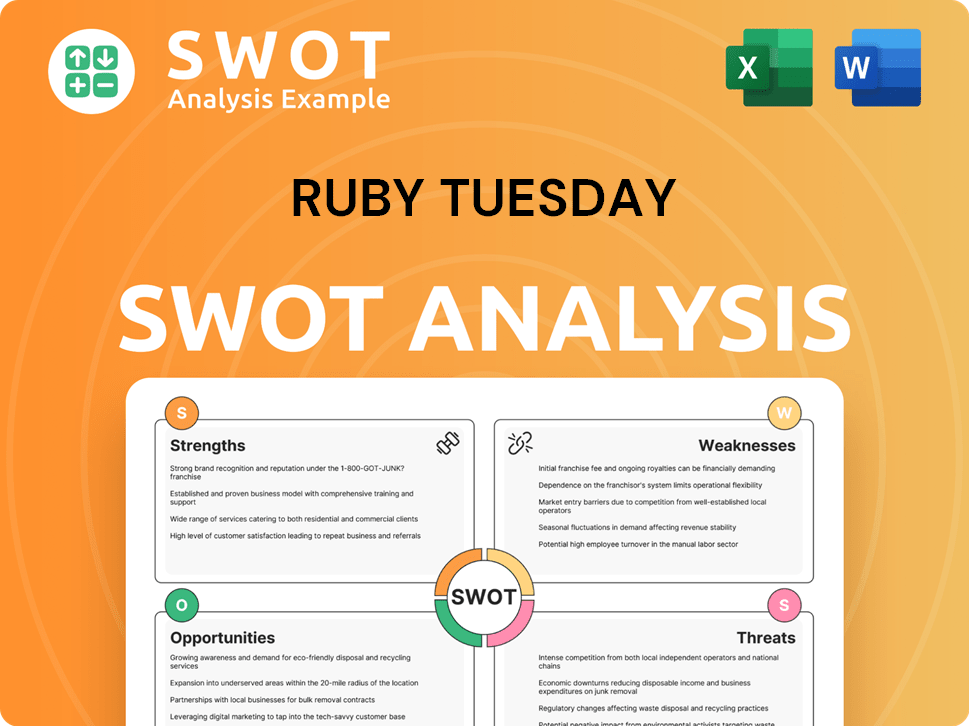
What Drove the Early Growth of Ruby Tuesday?
The early years of the Ruby Tuesday restaurant chain were marked by rapid expansion and strategic acquisitions. From its inception in 1972, the company demonstrated a strong growth trajectory, quickly establishing itself in the casual dining market. This period laid the groundwork for future developments and solidified its presence in the industry. The Ruby Tuesday timeline showcases a series of key events that shaped its trajectory.
Following its 1972 establishment, the Ruby Tuesday restaurant chain experienced consistent growth. New locations opened approximately every nine months, reaching 16 units by April 1982. This early expansion highlighted the market's positive reception of its casual dining concept, setting the stage for future growth. The Ruby Tuesday history is filled with strategic moves.
In April 1982, Ruby Tuesday founder Sandy Beall sold the 16-unit chain to Morrison Inc. for $15 million in cash and stock. Beall became president of Morrison's Specialty Restaurant Division, which included Ruby Tuesday locations. By 1985, the chain had more than doubled to 35 locations, contributing significantly to Morrison's success. The acquisition was a key event in the Ruby Tuesday timeline.
Morrison Inc. was renamed Morrison Restaurants Inc. in 1992, and the dining division was reorganized as the Ruby Tuesday Group. The company shifted its distribution strategy, moving from shopping mall locations to more freestanding restaurants. In 1995, Ruby Tuesday began its international expansion, with its first international location opening in Hong Kong. Read more about the Marketing Strategy of Ruby Tuesday.
In 1996, Morrison Restaurants Inc. was dissolved into three separate companies, with Ruby Tuesday Inc. becoming an independent entity. The company also operated other restaurant brands, including L&N Seafood Grill. Franchising of the Ruby Tuesday concept began in 1997. The Ruby Tuesday restaurant chain continued to evolve and adapt to market changes.
Ruby Tuesday PESTLE Analysis
- Covers All 6 PESTLE Categories
- No Research Needed – Save Hours of Work
- Built by Experts, Trusted by Consultants
- Instant Download, Ready to Use
- 100% Editable, Fully Customizable
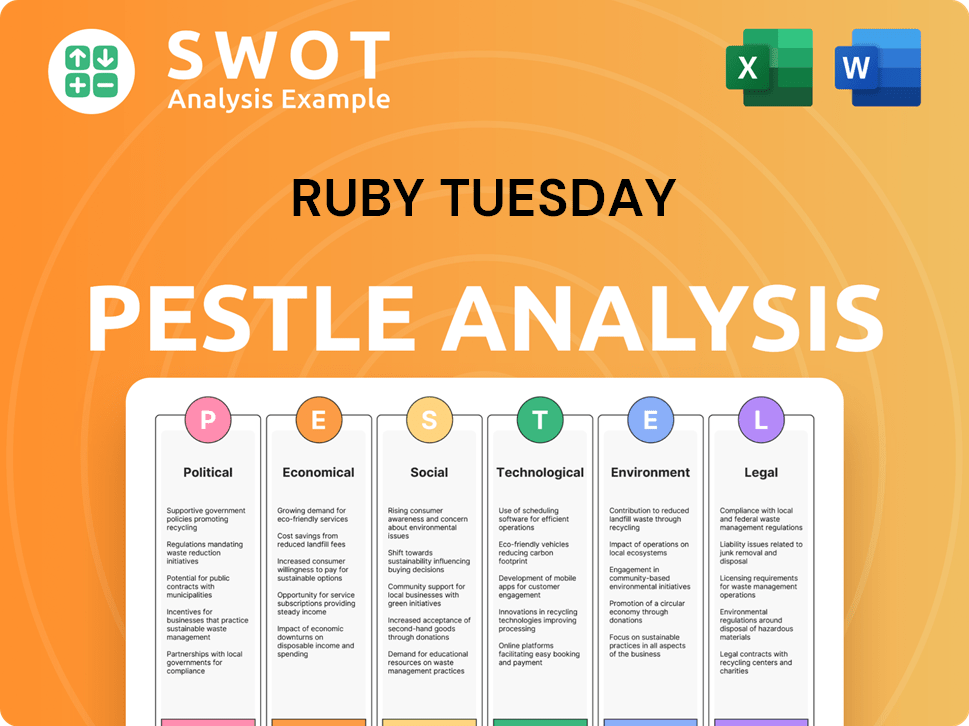
What are the key Milestones in Ruby Tuesday history?
The Ruby Tuesday history is marked by significant milestones, including its founding and the introduction of key menu items. The company has navigated various challenges, adapting to changes in the competitive casual dining landscape.
| Year | Milestone |
|---|---|
| 1972 | The first Ruby Tuesday restaurant opened in Knoxville, Tennessee, marking the beginning of the chain. |
| 1982 | The company went public, expanding its reach and influence in the restaurant industry. |
| 2007 | Acquired by a private equity firm, the company underwent significant strategic changes. |
| 2020 | Filed for Chapter 11 bankruptcy protection due to financial difficulties and the impact of the COVID-19 pandemic. |
| 2024-2025 | Continued to adapt and restructure, with some locations closing and strategic pivots in response to market changes. |
From its inception, the company introduced the Fresh Garden Bar, a key innovation that became a signature offering. The company has consistently focused on 'uncompromising freshness and quality' in its menu items, from burgers made with fresh ground beef to fresh seafood and all-natural chicken entrees.
The Fresh Garden Bar was a key innovation, setting the restaurant apart and attracting customers. This offering became a central part of the brand's identity and appeal.
Emphasis on fresh ingredients, including fresh ground beef, seafood, and all-natural chicken, helped differentiate the brand. This focus on quality aimed to attract health-conscious consumers.
The company has periodically revamped its menu to stay relevant and competitive. These changes have aimed to offer value and appeal to a broader customer base.
The casual dining landscape is highly competitive, and the company has faced several challenges, including market downturns and internal crises. In October 2020, the company filed for Chapter 11 bankruptcy protection, largely due to the challenges posed by the COVID-19 pandemic.
The casual dining sector is very competitive, with new concepts continually emerging. This environment puts pressure on established brands to innovate and adapt.
By the mid-2010s, the brand struggled, leading to declining sales and traffic. The company faced significant financial losses, impacting its ability to compete effectively.
The Chapter 11 bankruptcy filing in October 2020, was a major challenge, reflecting years of struggle. This filing was largely due to the impact of the COVID-19 pandemic.
As of January 2025, some locations continued to close, such as the restaurant in the Meriden Mall, leaving only two in Connecticut. These closures reflect ongoing challenges in the industry.
Ruby Tuesday Business Model Canvas
- Complete 9-Block Business Model Canvas
- Effortlessly Communicate Your Business Strategy
- Investor-Ready BMC Format
- 100% Editable and Customizable
- Clear and Structured Layout
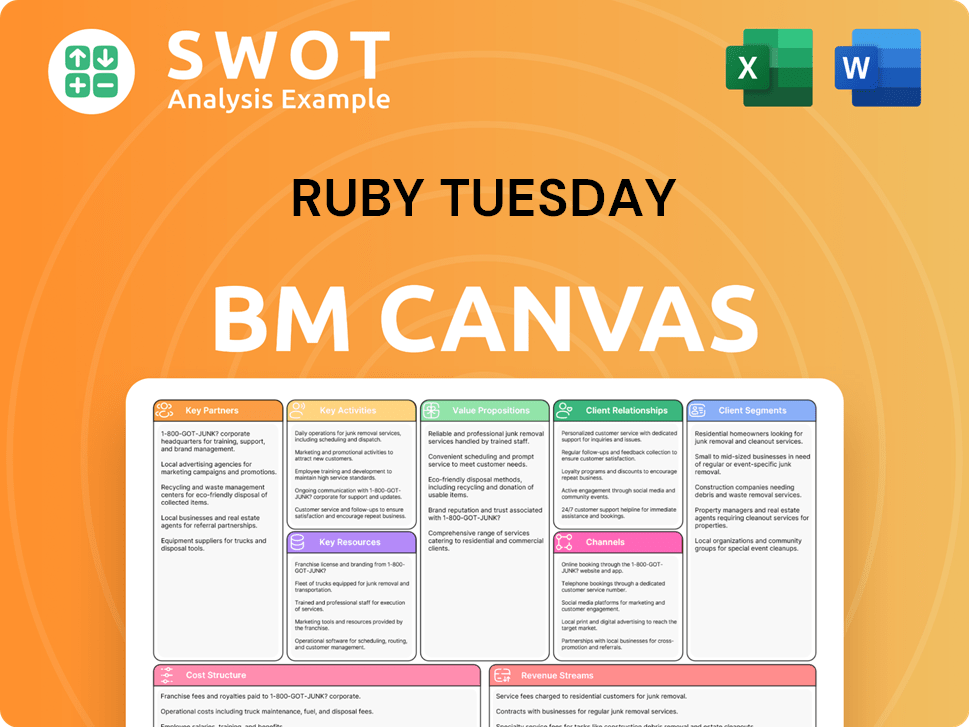
What is the Timeline of Key Events for Ruby Tuesday?
The Ruby Tuesday history is marked by significant milestones, from its humble beginnings to its current standing in the casual dining sector. The Ruby Tuesday restaurant
chain has seen considerable evolution since its inception.
| Year | Key Event |
|---|---|
| 1972 | Samuel E. (Sandy) Beall III opened the first Ruby Tuesday restaurant in Knoxville, Tennessee. |
| 1982 | Beall sold the 16-unit Ruby Tuesday chain to Morrison Inc. for $15 million. |
| 1995 | The first international Ruby Tuesday opened in Hong Kong. |
| 1996 | Morrison Restaurants Inc. split, and Ruby Tuesday Inc. became an independent entity. |
| 2000 | Ruby Tuesday Inc. focused solely on its namesake brand by divesting other restaurant brands. |
| 2017 | A new menu and enhanced Garden Bar were introduced nationwide as part of a 'Fresh Start' initiative. |
| 2020 | Ruby Tuesday filed for Chapter 11 bankruptcy protection, closing 185 units due to the pandemic. |
| 2021 | Ruby Tuesday celebrated its 50th anniversary with a new menu featuring 'big, better, bolder burgers.' |
| 2024 | A fire incident occurred at a location in Loganville, Georgia, which is under investigation. |
| 2025 | The Meriden Mall location closed, leaving only two remaining in Connecticut; a Knoxville location received a full refresh. |
To stay competitive, Ruby Tuesday may continue to innovate its Ruby Tuesday menu
, introducing new items and seasonal offerings. This could involve updating classic dishes or incorporating new culinary trends. The focus will likely be on appealing to current consumer preferences, like healthier options or more diverse flavors.
Enhancing the customer experience is crucial for driving repeat business. This could include improvements in service quality, restaurant ambiance, and the integration of technology for online ordering and reservations. Creating a welcoming environment is key.
Operational efficiency is vital for profitability. The company might streamline its operations, manage costs effectively, and optimize its supply chain. This can involve using technology to manage inventory and reduce waste.
Ruby Tuesday may adjust its Ruby Tuesday locations
to align with market demands. This might involve closing underperforming units or expanding in high-potential areas. Strategic decisions about the restaurant footprint are essential for sustainable growth.
Ruby Tuesday Porter's Five Forces Analysis
- Covers All 5 Competitive Forces in Detail
- Structured for Consultants, Students, and Founders
- 100% Editable in Microsoft Word & Excel
- Instant Digital Download – Use Immediately
- Compatible with Mac & PC – Fully Unlocked
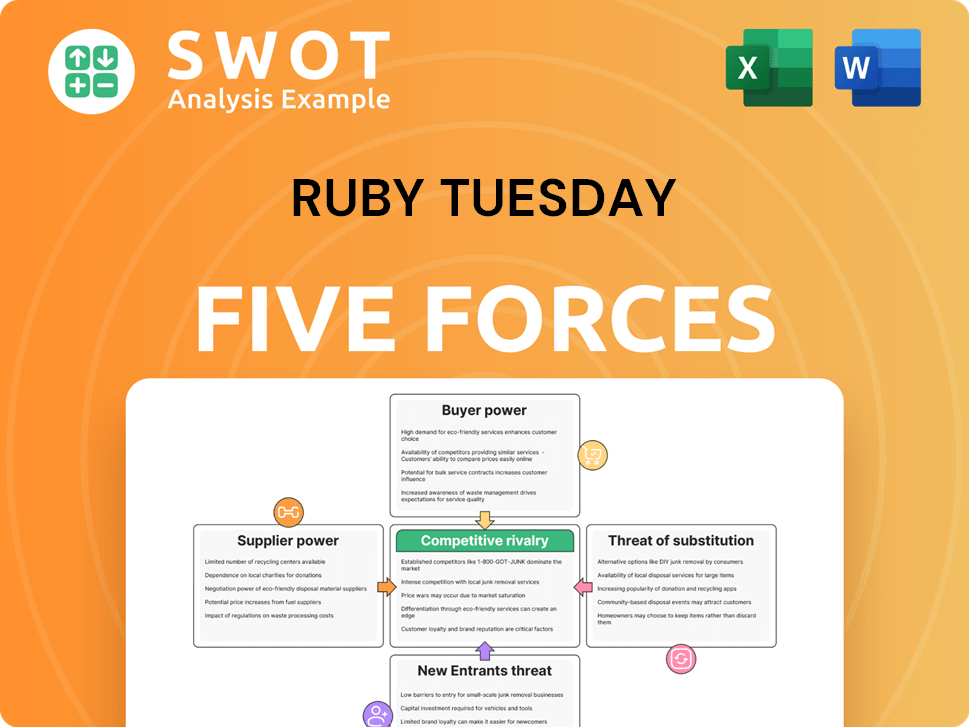
Related Blogs
- What is Competitive Landscape of Ruby Tuesday Company?
- What is Growth Strategy and Future Prospects of Ruby Tuesday Company?
- How Does Ruby Tuesday Company Work?
- What is Sales and Marketing Strategy of Ruby Tuesday Company?
- What is Brief History of Ruby Tuesday Company?
- Who Owns Ruby Tuesday Company?
- What is Customer Demographics and Target Market of Ruby Tuesday Company?
Disclaimer
All information, articles, and product details provided on this website are for general informational and educational purposes only. We do not claim any ownership over, nor do we intend to infringe upon, any trademarks, copyrights, logos, brand names, or other intellectual property mentioned or depicted on this site. Such intellectual property remains the property of its respective owners, and any references here are made solely for identification or informational purposes, without implying any affiliation, endorsement, or partnership.
We make no representations or warranties, express or implied, regarding the accuracy, completeness, or suitability of any content or products presented. Nothing on this website should be construed as legal, tax, investment, financial, medical, or other professional advice. In addition, no part of this site—including articles or product references—constitutes a solicitation, recommendation, endorsement, advertisement, or offer to buy or sell any securities, franchises, or other financial instruments, particularly in jurisdictions where such activity would be unlawful.
All content is of a general nature and may not address the specific circumstances of any individual or entity. It is not a substitute for professional advice or services. Any actions you take based on the information provided here are strictly at your own risk. You accept full responsibility for any decisions or outcomes arising from your use of this website and agree to release us from any liability in connection with your use of, or reliance upon, the content or products found herein.